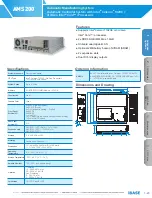
S&C Instruction Sheet 662-510
7
Safety Precautions
DANGER
Pad-mounted gear contains high voltage. Failure to observe the precautions
below will result in serious personal injury or death.
Some of these precautions may differ from company operating procedures and
rules. Where a discrepancy exists, users should follow their company’s operating
procedures and rules.
1.
QUALIFIED PERSONS. Access to pad-mounted
gear must be restricted only to qualified persons.
See the “Qual ified Persons” section on page 2.
2.
SAFETY PROCEDURES. Always follow safe
operat ing procedures and rules.
3.
PERSONAL PROTECTIVE EQUIPMENT. Always
use suitable protective equipment, such as rubber
gloves, rubber mats, hard hats, safety glasses, and
flash clothing in accordance with safe operating
procedures and rules.
4.
SAFETY LABELS. Do not remove or obscure any
of the “CAUTION,” “WARNING,” or “DANGER”
labels.
5.
KEY INTERLOCKS.
• If optional key interlocks were furnished, they
must be in place.
• Check the operating sequence of key interlocks
to verify proper sequencing.
• After the pad-mounted gear is installed, either:
(1) destroy the extra set of keys or (2) make
them accessi ble only to qualified persons. This
will maintain the integrity of the key-interlock
scheme.
• Key interlocks are not security locks and are
not substitutes for padlocks.
6.
OPENING DOORS. Do not force doors open.
Forcing a door open can damage the latching
mechanism. If optional key interlocks are provided,
correctly position the interlocks so the doors can be
opened.
7.
CLOSING AND LOCKING DOORS.
• Doors must be securely closed and latched,
with padlocks in place at all times unless work is
being performed inside the enclosure.
• Mini-Rupter Switches have switch-operating-
shaft access covers located on the sides of the
pad- mounted gear enclosure. They must be
closed and padlocked at all times unless the
switches are being operated.
8.
ENERGIZED TERMINALS. Always assume both
sets of power terminals on any Mini-Rupter Switch
or fuse are energized unless proved otherwise by
test, by visual evidence of open-circuit conditions
on both sets of terminals, or by observing that both
sets of ter minals are grounded.
9.
BACKFEED. Mini-Rupter Switches and fuses may
be energized by backfeed.
10.
DE-ENERGIZING, TESTING, AND GROUNDING.
Before touching any device that is to be inspected,
replaced, serviced, or repaired in the high-voltage
compartments, always disconnect Mini-Rupter
Switches and fuses from all power sources
(including backfeed), test for voltage, and properly
ground.
11.
TESTING. Test for voltage on both sets of power
ter minals of any Mini-Rupter Switch or fuse
using proper high-voltage test equipment before
touching any device that is to be inspected,
replaced, serviced, or repaired in the high-voltage
compartments.
12.
GROUNDING.
• Make sure the pad-mounted gear enclosure is
properly grounded to the station or facility
ground.
• After the gear has been completely disconnected
from all sources of power and tested for
voltage, install suitable grounding cables in all
compart ments before touching any device to be
inspected, replaced, serviced, or repaired in the
high-voltage compartments.
13.
SWITCH POSITION.
• Always confirm the
Open/Close position of
Mini-Rupter Switches by visually observing the
position of the switch blades.
• Switches may be energized by backfeed.
• Switches may be energized in any position.
14.
MAINTAINING PROPER CLEARANCE. Always
maintain proper clearance from energized
compo nents.
15.
FUSE STORAGE.
• Always store fuses in a clean, dry location.
• Do not store end-fittings, holders, interrupting
modules, or fuses in termination compartments
unless the unit is equipped with the optional
fuse-storage feature (catalog number suffix
“-E1,” “-E2,” or “-E3”).








































